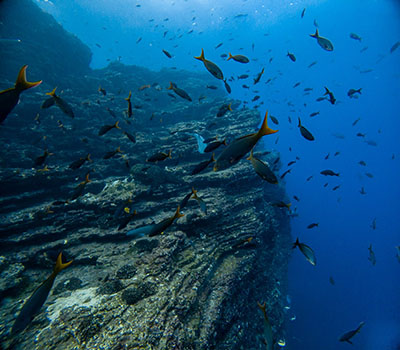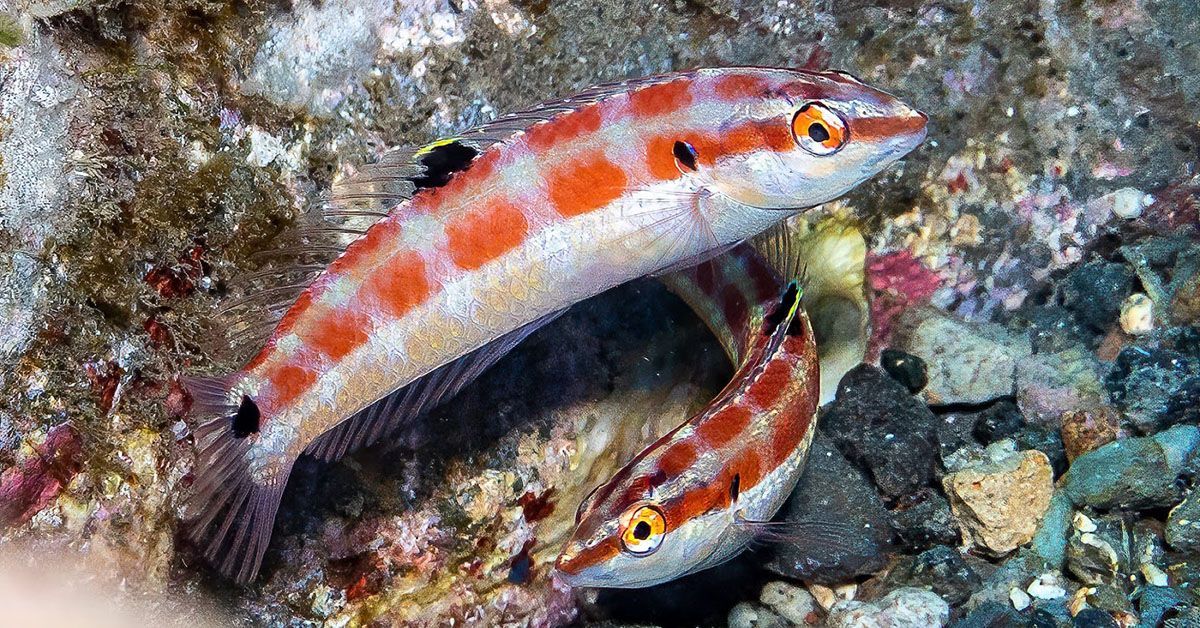New Fish Species Discovered at Remote Islands Off Mexico’s Pacific Coast
Species is a wrasse found living among volcanic rubble in Mexico’s Revillagigedo Archipelago
Story by:
Published Date
Article Content
A team of scientists including Ben Frable of UC San Diego’s Scripps Institution of Oceanography have discovered a new species of tropical fish during an expedition to the remote islands of the Revillagigedo Archipelago off Mexico’s Pacific coast. The fish is likely endemic to these islands, meaning it is found no place else on Earth. The Revillagigedos are sometimes called the “Mexican Galapagos” for their trove of marine biodiversity and rugged beauty.
The researchers describe the new species, dubbed Halichoeres sanchezi or the tailspot wrasse, in a paper published Feb. 28 in the journal PeerJ. Halichoeres sanchezi was named in honor of marine scientist Carlos Armando Sánchez Ortíz of the Universidad Autónoma de Baja California Sur (UABCS) who collected the first specimen and who organized the 2022 expedition that led to the fish’s discovery.
The eight specimens of the new species collected by the team range in size from around an inch long to nearly six inches. The smaller females of the species are mostly white with reddish horizontal stripes along their top half and black patches on their dorsal fin, behind their gills, and just ahead of their tail fin. Frable described the males as “orangy red up top fading to a yellow belly with a dark band at the base of the tail.”
Halichoeres sanchezi is a member of the wrasse family, a highly diverse and colorful group of more than 600 species. Most wrasse are less than seven inches long, such as the bluestreak cleaner wrasse (Labroides dimidiatus), but some get much larger like the California sheephead (Semicossyphus pulcher) or the massive humphead wrasse (Cheilinus undulatus), which can reach seven feet in length.

Large numbers of multiple species of fish at the edge of a rock reef off San Benedicto Island in the Revillagigedos Archipelago. Credit: Allison & Carlos Estape
Researchers encountered the new wrasse species inhabiting an underwater field of volcanic rubble at a depth of around 70 feet near San Benedicto Island.
San Benedicto is one of the four islands in Mexico’s Revillagigedo Archipelago, which anchor a marine protected area in which fishing is prohibited. The islands are located around 250 miles to the south of the Baja California peninsula and some 500 miles west of mainland Mexico’s coastline. The islands’ remote location and legal protections have created what Frable called a “window back in time to before intensive fishing – there are many sharks and big groupers that would be fished out in other places.”
This abundance of marine life attracts a steady stream of recreational scuba divers, but the islands’ undersea fauna remains much less well studied than other more famous archipelagos in the tropical eastern Pacific, such as the Galapagos. The last scientific assessment of the islands’ fishes occurred more than two decades ago, and Sánchez, along with Ross Robertson of the Smithsonian Tropical Research Institute and the underwater photographers Carlos and Allison Estape, moved to organize a more robust survey of the Revillagigedo Archipelago’s fish diversity that culminated in November 2022.
Frable’s participation in the expedition was supported by the Scripps Director’s Office, the Scripps Oceanographic Collections Fund, and the Lehman-Kennel Endowment for the Scripps Oceanographic Collections.
In addition to an international group of scientists from UABCS, Scripps, the Natural History Museum of Los Angeles County, the Smithsonian Tropical Research Institute, the Ocean Science Foundation, and the University of Central Florida, the expedition included 11 skilled underwater photographers, led by the Estapes, to improve the trip’s documentation of the underwater ecosystems they visited. Over the course of roughly two weeks, the group surveyed all four islands during 30 research dives that produced more than 5,500 photographs and 900 specimens representing more than 100 fish species. The researchers also took tissue samples from all the collected species for DNA analysis.
Those 900 specimens are now being stored in Scripps’ renowned Marine Vertebrate Collection, Mexico’s Colección Nacional de Peces, and the Natural History Museum of Los Angeles County where they will be preserved and accessible to researchers from all over the world.
During the expedition, Frable said the team was keen to encounter a mysterious wrasse that had been photographed by a diver in 2013 and appeared different than any known species. In the final days of the trip, the group was beginning to think the unidentified wrasse would remain mysterious.
On the last day of the expedition, Sánchez collected a small red fish off San Benedicto Island without being totally sure of its identity. Back on the boat, Frable said they realized this was a wrasse and was a match for the mystery photograph. But the team’s goal of documenting this potential new species wasn’t yet fully realized. Sánchez had collected a female, or what the scientists studying wrasse often call the “initial phase.” Male wrasse on the other hand can also be termed the “terminal phase,” and are typically much larger and more visually striking to woo females.
Scientists use these odd-seeming terms because many wrasse are what are called sequential hermaphrodites – meaning all fish begin life as female and then can later transition to male if the right circumstances arise.
On the second to last dive of the expedition Frable spotted the terminal phase of this unknown wrasse species, but it slipped through the team’s fingers and nets. Finally, on the very last dive of the trip, William Ludt, co-author of the study and assistant curator of ichthyology at the Natural History Museum of Los Angeles County, and Frable were able to collect an example of the species’ terminal phase.
In all, the researchers collected eight specimens from what they thought was sure to be a new species. Their suspicions were confirmed by subsequent DNA analysis which revealed genetic divergence from the fish’s two closest relatives – the golden wrasse (Halichoeres melanotis) from Panama and redstriped wrasse (Halichoeres salmofasciatus) from Cocos Island near Costa Rica – further supporting the conclusion that it was a distinct species.
The new species brings the tally of endemic fish species for the isolated archipelago to 14 and further bolsters the case for its continued protection by the Mexican government.
“It’s amazing that we can still find species that are new to science in a place where people are visiting pretty regularly – it just shows how big and complex the world is,” said Frable.
Frable said upcoming publications may reveal as many as two other new species from the specimens collected during the expedition. “We were able to gather a huge amount of scientific information in two weeks and the participation of so many talented underwater photographers was a unique and integral aspect of the expedition,” he added.
Returning to Revillagigedo for further study in the future is also likely to yield new discoveries, said Frable, as there were plenty of fish habitats, such as estuaries and tidal zones or deeper reefs hundreds of feet down, that the team wasn’t able to fully explore.
In addition to co-authors Frable and Ludt, Benjamin Victor of Nova Southeastern University and the Ocean Science Foundation was the lead author of the study.
The Scripps Oceanographic Collections are comprised of millions of biological and geological marine specimens, providing a record of the state of the ocean environment over the past century that serves as a resource to researchers and students all over the world. To support the collections, members of the public can join the membership group Friends of the Collections or consider naming a new species.
Share This:
Stay in the Know
Keep up with all the latest from UC San Diego. Subscribe to the newsletter today.




